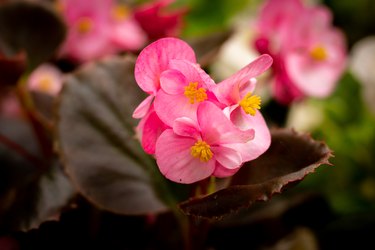
Being a pet owner comes with a large set of responsibilities. Besides feeding them, cleaning up after them and playing with them, you are in charge of your pets' health, safety and welfare. While it might be a lot of fun to let your dog run around in your yard or the park, you have to be very careful because some plants and flowers are toxic to them.
Begonias are not toxic to dogs, but they are toxic to other pets, like cats. Note that even though they're not toxic, if your dog eats a begonia, he may still vomit.
Video of the Day
Video of the Day
What Plants Are Toxic to Dogs?
Eating any plant material can cause dogs and cats to vomit, so pet owners should always be on the alert when pets pick things up with their mouth. You don't want to take your four-legged friend to the vet regularly, so it makes sense to know what foliage to steer clear of to avoid this sort of adverse reaction. Also, remember that even if the dog doesn't vomit, she still isn't getting much nutritional value from the plant.
The American Society for the Prevention of Cruelty to Animals has lists of plants that are toxic and nontoxic to dogs and cats on its website. Some of the more common toxic plants for dogs include aloe, buttercups, chrysanthemum, mistletoe, peonies and daisies.
Plants That Are Nontoxic to Dogs
The list of plants that are nontoxic to dogs is just about as long as the one that lists poisonous plants. Better-known safe ones include the canna lily, hibiscus, roses and begonias. Fans of these lovely flowers can grow them in their yard, but you should be extra careful to keep pets away because you don't want the plants to get damaged.
Now that you know begonias are safe for dogs, you should also be aware that they are toxic to cats. However, there are many nontoxic flowers that are harmless for feline friends.
All About Begonias
If you are ready to grow these colorful, textured flowers, they thrive when planted in containers placed in filtered shade. You can also grow begonias in the ground, where they prefer rich, fast-draining soil.
Begonias can also do well as indoor plants, but you have to give them enough humidity. Whether you plant them indoors or outside, keep the soil moist but not soggy. You can add a bit of compost to retain moisture and always water begonias at the base because if their leaves get too damp, you can end up with leaf spots and leaf rot. Plant annual begonias in the spring after the first frost has ended. They favor warmer temperatures, and if it drops below 50 degrees Fahrenheit, they can become damaged or die.
You can mix a balanced fertilizer into your soil before planting the begonias plus a water-soluble fertilizer once a month. Also, make sure you deadhead the spent blooms that are past their prime and these plants will bloom for the whole summer and look healthier as well. If you've never grown begonias before, you should start with smaller ones, like the rhizomatous begonias. These begonias are modest in size, do well in containers on windowsills and have beautifully textured and colored leaves that almost steal the attention from the lovely flowers.